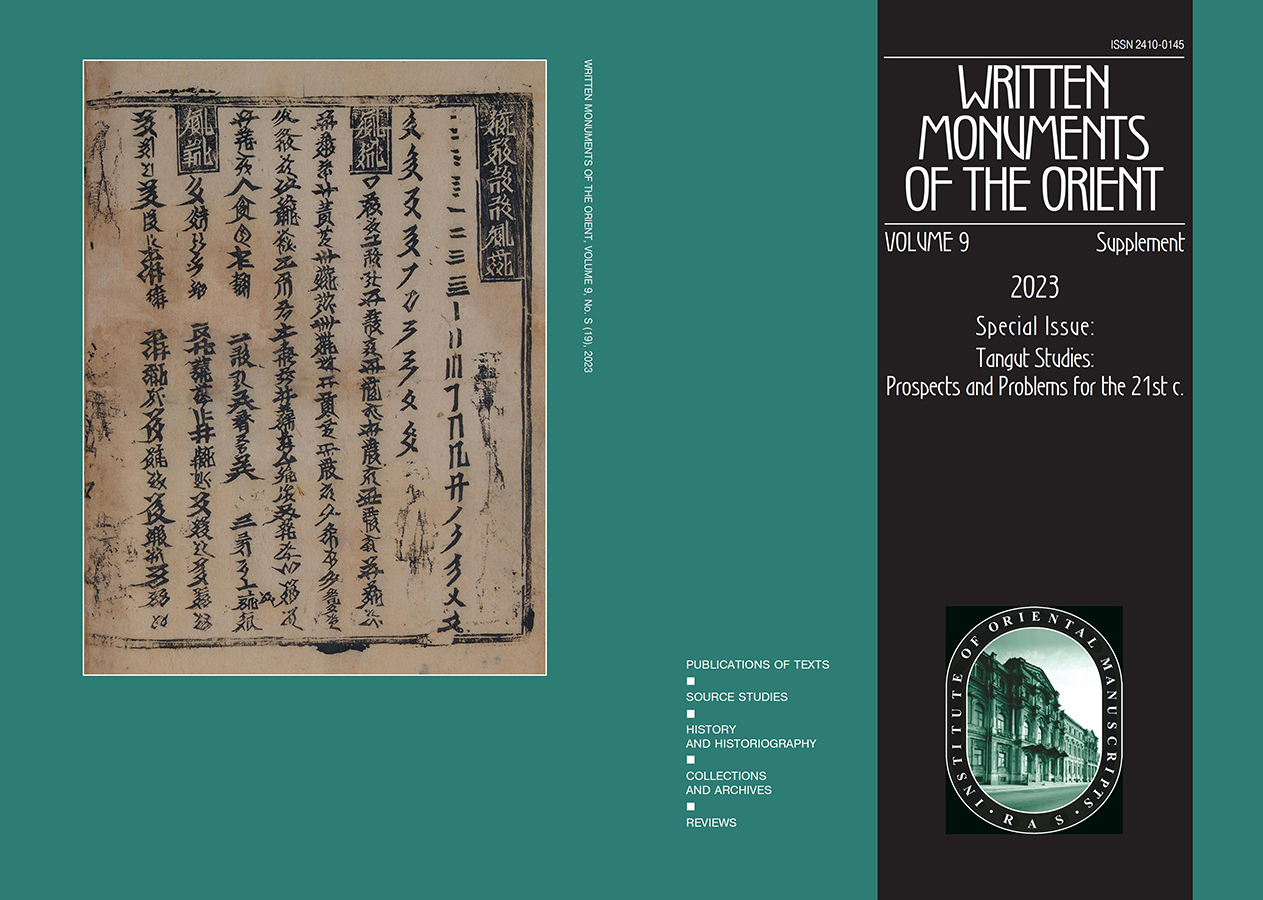Pilgrimage in Western Xia: Research on Tangut Wall Inscriptions in the Mogao and Yulin Caves
- Authors: Kuzmin N.1
-
Affiliations:
- Independent Scholar
- Issue: Vol 9, No 1S (2023)
- Pages: 49-62
- Section: Original Papers
- Published: 15.11.2023
- URL: https://journals.eco-vector.com/2410-0145/article/view/569219
- DOI: https://doi.org/10.55512/wmo569219
- ID: 569219
Cite item
Full Text
Abstract
The Tanguts who established Western Xia (982–1227) were active and devoted Buddhist pilgrims. They visited the Buddhist cave complexes of Mogao and Yulin in the Greater Dunhuang area and left several hundred lines of wall inscriptions. The paper examines various types of the remaining Tangut pilgrimage inscriptions and formulates their common textual formula. The comparative study of the resemblant Chinese, Tangut, and Uyghur inscriptions reveals their structural and vocabulary similarities and suggests the existence of the multilingual “inscriptional discourse” in the greater Dunhuang area in the 10th–14th cc. Finally, the content analysis of the inscriptions illuminates the features of the Buddhist pilgrimage as a local social and religious phenomenon and provides a precious primary textual source for the study of Western Xia.
Keywords
About the authors
Nikita Kuzmin
Independent Scholar
Author for correspondence.
Email: kitnikitakuzmin@gmail.com
ORCID iD: 0000-0001-9824-2507
Ph.D.
United States, CaliforniaReferences
- DUNHUANG YANJIUYUAN 敦煌研究院 1986: Dunhuang Mogaoku gongyangren tiji 敦煌莫高窟供养人题记 [Donor Inscriptions in Dunhuang Mogao Caves]. Beijing: Wenwu chubanshe.
- HIRAKAWA Akira 平川彰 1997: Buddhist Chinese-Sanskrit Dictionary = Bukkyō Kanbon daijiten 佛教漢梵大辭典. Tokyo: The Reiyukai.
- KYCHANOV, Evgeny I. 1999: Catalogue of Tangut Buddhist Monuments of the Institute of Oriental Studies of the Russian Academy of Sciences. Kyoto: University of Kyoto.
- LI Tao 李濤 1985: Xu zizhi tongjian changbian 續資治通鑑長編 [Extended Continuation to Comprehensive Mirror in Aid of Governance]. Beijing: Zhonghua shuju.
- MATSUI Dai 松井太 & ARAKAWA Shintarō 荒川慎太郎 2017: Tonkō sekkutsu tagengo shiryō shūsei 敦煌石窟多言語資料集成 [Multilingual Source Materials of the Dunhuang Grottoes]. Tokyo: Tokyo University of Foreign Studies.
- TUO TUO 脫脫 1980: Songshi 宋史 [The History of Song]. Taibei: Dingwen shuju.
- NINGXIA DAXUE XIXIA YANJIU ZHONGXIN 寧夏大學西夏研究中心, GUOJIA TUSHUGUAN 國家圖書館, GANSUSHENG GUJI WENXIAN ZHENGLI BIANYI ZHONGXIN 甘肅省古籍文獻整理編譯中心 2005: Zhongguo cang Xixia wenxian 中國藏西夏文獻 [Xixia Textual Materials Preserved in China]. Lanzhou: Gansu renmin chubanshe: Dunhuang wenyi chubanshe.
- BAI Bin 白滨 1984: Xixiashi lunwenji 西夏史论文集 [Collection of articles on the history of Xixia]. Yinchuan: Ningxia renmin chubanshe.
- BUDDHISTROAD TEAM (Carmen MEINERT et al.) 2018: “Dynamics in Buddhist Transfer in Eastern Central Asia 6th–14th Centuries: A Project Report”. Medieval Worlds 8: 126–134.
- HAMILTON, James & NIU Ru-ji 1998: “Inscriptions oui’goures des grottes bouddhiques de Yulin”. Journal Asiatique 286(1): 127–210.
- HANSEN, Valerie 2012: The Silk Road: A New History. Oxford: Oxford University Press.
- KYCHANOV, Evgeny I. 2012: “Dunhuang as Part of the Tangut Empire”. In: Dunhuang Stu¬dies: Prospects and Problems of the Coming Second Century of Research. St. Petersburg: Slavia: 127–130.
- MATSUI Dai 松井太 2018: “Yulinku di 16 ku Xuliyazi Huihuwen jingjiaotu tiji” 榆林窟第16窟叙利亚字回鹃文景教徒题记 [The Syro-Uighur Christian Inscription of Yulin Cave 16]”. Dunhuang yanjiu 敦煌研究 [Dunhuang Research] 2(168): 34–39.
- MONIER-WILLIAMS, Monier 1899: A Sanskrit-English dictionary: Etymologically and philolo¬gically arranged with special reference to cognate Indo-European languages. Oxford:
- At the Clarendon Press.
- NEVSKY, Nikolai A. 1960: Tangutskaia filologiia: Issledovaniia i slovar’. V dvukh knigakh [Tangut Philology: Studies and Dictionary. In Two Volumes]. Vol. 1. Moscow: Izda-tel’stvo vostochnoi literatury [Oriental Literature Publishing House].
- OKAZAKI Seirō 岡崎精郎 1972: Tangūto Kodaishi Kenkyū タングート古代史研究 [Research on the Ancient History of Tanguts]. Kyōto: Toyoshi Kenkyukai.
- PELLIOT, Paul 1908: “Une Bibliothèque Médiévale Retrouvée Au Kan-Sou”. Bulletin de l’École Française d’Extrême-Orient 8(3–4) (juillet-décembre 1908): 501–529.
Supplementary files








